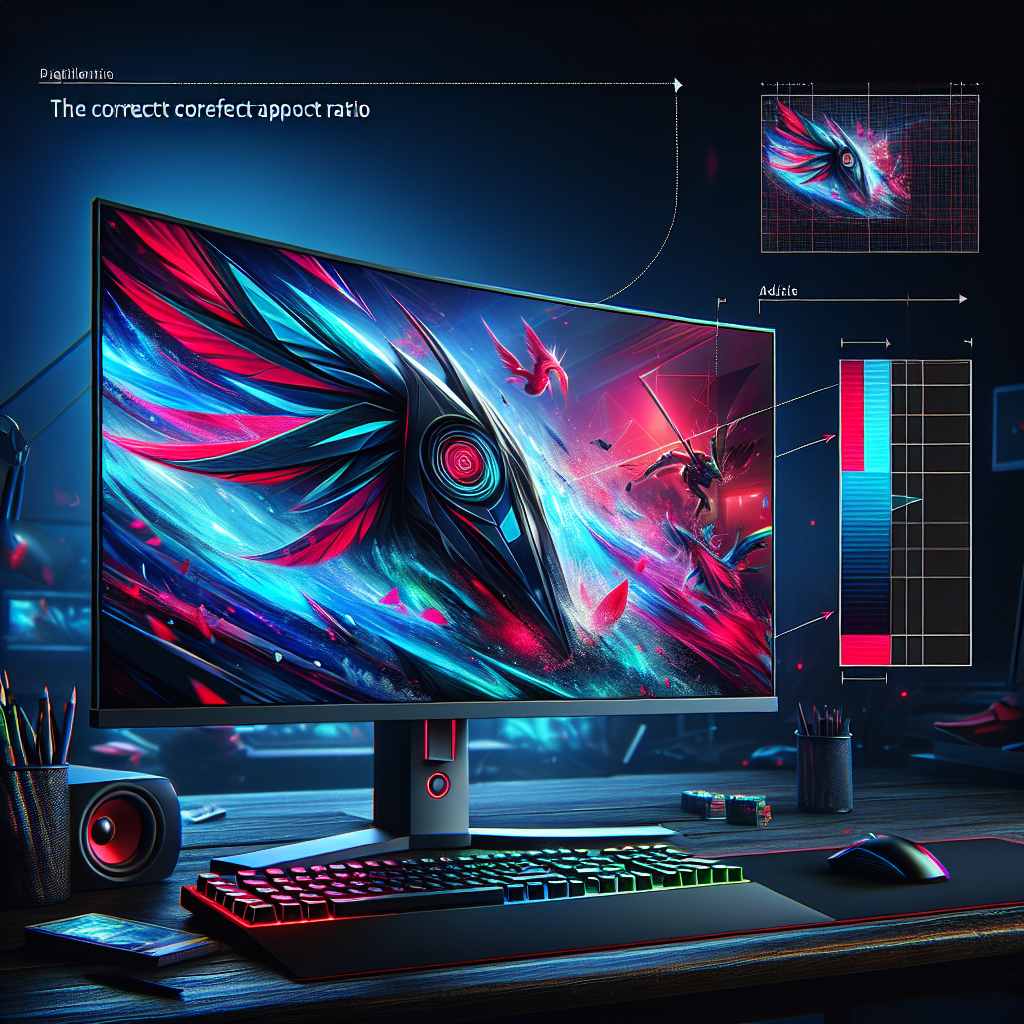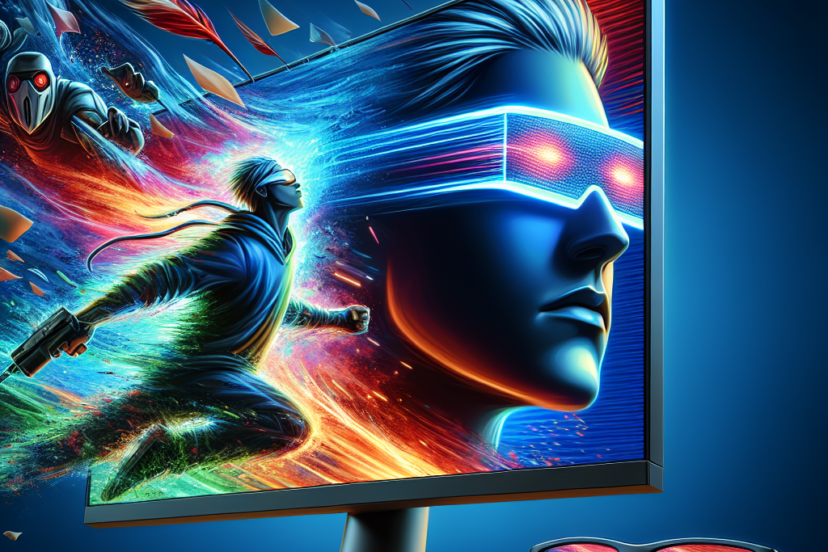What Is A Good Aspect Ratio For A Gaming Monitor?
Are you tired of playing your favorite games on a cramped screen? Well, look no further! In this article, we will guide you through the world of aspect ratios for gaming monitors and help you find the perfect fit for an immersive gaming experience. Whether you’re into action-packed shooters or visually stunning RPGs, understanding aspect ratios is crucial to enhancing your gameplay. Get ready to level up and discover the ideal aspect ratio for your gaming monitor!

Understanding Aspect Ratio
Definition of Aspect Ratio
Aspect ratio refers to the proportional relationship between the width and height of a display screen or image. It is expressed as two numbers separated by a colon, such as 16:9 or 21:9. The first number represents the width, while the second number represents the height. Aspect ratio plays a crucial role in determining how content is displayed on a gaming monitor, as it directly affects the visual experience during gameplay.
Importance of Aspect Ratio in Gaming
The aspect ratio of a gaming monitor is essential because it determines the horizontal and vertical viewing area available to gamers. The choice of aspect ratio can impact how immersive and visually engaging the gaming experience is, as well as affect the gameplay itself. Different aspect ratios offer unique advantages and disadvantages, so understanding them is crucial in making an informed decision when choosing a gaming monitor.
Common Aspect Ratios in Gaming Monitors
There are several common aspect ratios found in gaming monitors, each with its own characteristics and suitability for different types of games and gaming setups. The most popular aspect ratios in gaming are 16:9 (standard), 21:9 (ultra-wide), 32:9 (super ultra-wide), 4:3 (retro), and 16:10 (balance between productivity and entertainment). Let’s delve into each of these aspect ratios and explore their advantages, disadvantages, and examples of popular gaming monitors for each category.
16:9 – The Standard
Overview of 16:9 Aspect Ratio
The 16:9 aspect ratio is the most common and widely adopted standard for gaming monitors. It offers a rectangular shape with a wider field of view in comparison to older 4:3 aspect ratios. This aspect ratio provides a great balance between immersive gameplay and maintaining a competitive edge by allowing gamers to see more of the game world without excessive head movement.
Advantages of 16:9 in Gaming
One major advantage of the 16:9 aspect ratio is its widespread support across gaming titles and platforms. The majority of games are designed and optimized for this aspect ratio, ensuring seamless compatibility and a consistent visual experience. Additionally, 16:9 monitors are generally more affordable compared to their ultra-wide counterparts, making them an accessible choice for gamers on a budget.
Disadvantages of 16:9 in Gaming
While 16:9 is the standard, it may not provide the same level of immersion and peripheral visibility as wider aspect ratios. The limited horizontal space may result in a narrower field of view, which can be a disadvantage in certain gaming genres, such as first-person shooters or racing games. Additionally, the vertical space in 16:9 monitors may feel restrictive for tasks that require vertical scrolling, such as web browsing or working on documents.
Examples of Popular 16:9 Gaming Monitors
Some popular 16:9 gaming monitors include the ASUS VG245H and BenQ PD3200U. These monitors offer various features such as high refresh rates, low response times, and adaptive sync technologies to enhance the gaming experience within the 16:9 aspect ratio.
21:9 – Ultra-Wide Immersion
Overview of 21:9 Aspect Ratio
The 21:9 aspect ratio, also known as ultra-wide, provides a wider panoramic view compared to the standard 16:9 ratio. It creates a more immersive experience by expanding the horizontal field of view, allowing gamers to enjoy a greater sense of depth and detail.
Advantages of 21:9 in Gaming
The primary advantage of the 21:9 aspect ratio is the enhanced immersion it offers. With its wider screen real estate, the ultra-wide aspect ratio gives gamers a more expansive view of their game worlds and allows for better peripheral vision. This is particularly beneficial in games that emphasize beautiful landscapes, immersive storylines, and a cinematic experience. Moreover, the additional screen space provided by 21:9 monitors can also be advantageous for multitasking or content creation.
Disadvantages of 21:9 in Gaming
One potential drawback of the 21:9 aspect ratio is the limited support for ultra-wide resolutions in certain games. While many modern titles now offer native support for 21:9 displays, older or less popular games may not fully utilize the wider aspect ratio, resulting in pillarboxing or stretched images. Additionally, ultra-wide monitors tend to come with a higher price tag, making them less accessible for gamers with budget constraints.
Examples of Popular 21:9 Gaming Monitors
Popular gaming monitors in the 21:9 aspect ratio include the LG 34GN850-B and Acer Predator X35. These monitors offer high refresh rates, wide color gamuts, and features like HDR (High Dynamic Range) to provide an exceptional gaming experience within the ultra-wide aspect ratio.
32:9 – Super Ultra-Wide
Overview of 32:9 Aspect Ratio
The 32:9 aspect ratio, also known as super ultra-wide, takes immersion to the next level by providing an even wider field of view compared to 21:9 monitors. These monitors feature an extremely wide and elongated display, simulating a panoramic view that mimics the human peripheral vision.
Advantages of 32:9 in Gaming
The major advantage of the 32:9 aspect ratio is the unparalleled level of immersion it delivers. With the extended horizontal screen space, gamers can experience a truly encompassing view, allowing for a more realistic and engaging gaming experience. This aspect ratio is particularly well-suited for games that prioritize peripheral awareness and panoramic environments, such as flight simulators and open-world exploration games.
Disadvantages of 32:9 in Gaming
One notable disadvantage of the 32:9 aspect ratio is the limited support from game developers. Due to its niche status, not all games fully utilize the super ultra-wide aspect ratio, leading to compatibility issues or improper scaling. Additionally, the price point of 32:9 monitors is significantly higher than standard or ultra-wide monitors, making them a less practical choice for gamers on a tight budget.
Examples of Popular 32:9 Gaming Monitors
Prominent examples of 32:9 gaming monitors include the Samsung Odyssey G9 and the LG 38GN950-B. These monitors offer cutting-edge features such as high refresh rates, curved screens, and HDR support to deliver an unmatched gaming experience within the super ultra-wide aspect ratio.

4:3 – Retro Gaming Experience
Overview of 4:3 Aspect Ratio
The 4:3 aspect ratio, although less common in modern gaming, holds nostalgic value for retro gaming enthusiasts. This aspect ratio was prevalent in earlier gaming consoles and arcade machines, lending a classic and authentic feel to games from that era.
Advantages of 4:3 in Gaming
The primary advantage of the 4:3 aspect ratio is its ability to retain the original aesthetics of retro games. Playing these games in their intended aspect ratio preserves the pixel-perfect graphics and the nostalgic experience they offer. Additionally, 4:3 monitors can be an affordable option for those seeking a retro gaming setup, as they are often available at lower price points.
Disadvantages of 4:3 in Gaming
One significant drawback of the 4:3 aspect ratio is its limited compatibility with modern gaming titles. Most contemporary games are designed for wider aspect ratios, which may result in stretched or distorted images when played on a 4:3 monitor. Additionally, the narrow horizontal field of view in the 4:3 aspect ratio may impact immersion and hinder competitive gameplay in certain genres that require wider peripheral vision.
Examples of Popular 4:3 Gaming Monitors
While 4:3 monitors are less commonplace in the gaming market today, some examples include the AOC G2590FX and Dell UltraSharp 1908FP. These monitors cater to retro gaming enthusiasts and offer compatibility with older gaming consoles and devices.
16:10 – A Balance Between Productivity and Entertainment
Overview of 16:10 Aspect Ratio
The 16:10 aspect ratio strikes a balance between productivity and entertainment, making it an attractive option for gamers who require a versatile display for both gaming and work-related tasks. It offers a slightly taller screen compared to the standard 16:9, providing additional vertical space for multitasking and productivity applications.
Advantages of 16:10 in Gaming
One of the significant advantages of the 16:10 aspect ratio is the added vertical space it provides. This can be beneficial for games that involve vertical scrolling or require a clear view of the environment from top to bottom, such as strategy games or simulation titles. The taller screen also enhances the readability of text-based content, making it suitable for gamers who engage in text-heavy games or MMOs (Massively Multiplayer Online) that involve extensive communication.
Disadvantages of 16:10 in Gaming
A potential drawback of the 16:10 aspect ratio is its limited availability in gaming monitors compared to more mainstream ratios like 16:9 or 21:9. This may restrict the options available to gamers seeking to purchase a monitor within this aspect ratio. Additionally, the extra vertical space in 16:10 monitors may lead to black bars or pillarboxing when playing games that are optimized for wider aspect ratios.
Examples of Popular 16:10 Gaming Monitors
Popular gaming monitors in the 16:10 aspect ratio include the Dell UltraSharp U2415 and the HP Z24n G2. These monitors offer excellent color accuracy, wide viewing angles, and ergonomic design, making them suitable for both gaming and professional tasks.

Custom Resolutions and Aspect Ratios
Defining Custom Resolutions
Custom resolutions allow gamers to create unique aspect ratios that suit their specific preferences or gaming requirements. By manually inputting the desired width and height, players can experiment with unconventional aspect ratios and resolutions that may enhance their gaming experience.
Compatibility and Support
One important consideration when opting for custom resolutions and aspect ratios is the compatibility and support from game developers and hardware manufacturers. Not all games and graphics cards may be capable of accommodating custom resolutions, which can result in compatibility issues or improper scaling. It is vital to ensure that the hardware and software used can handle the desired custom resolution effectively.
Benefits and Drawbacks
The benefits of custom resolutions and aspect ratios lie in the ability to fine-tune the visual experience to suit personal preferences and gaming styles. Custom resolutions can offer a unique perspective or tailor the viewport to specific gaming genres. However, it is crucial to note that the widespread support and optimization available for standard aspect ratios may be absent when utilizing custom resolutions, potentially leading to compatibility issues and reduced visual fidelity in certain games.
Choosing the Right Aspect Ratio
Consider the Game Genre
When selecting the ideal aspect ratio, it is essential to consider the game genres that you frequently play. Different genres have varying requirements in terms of field of view, immersion, and competitive advantage. First-person shooters and racing games, for example, benefit from wider aspect ratios like 21:9 or 32:9 that offer greater peripheral awareness, while strategy or simulation games may benefit from the added vertical space of 16:10.
Evaluate Personal Preferences
Personal preferences should also be taken into account when choosing the aspect ratio for a gaming monitor. Some individuals may favor a cinematic gaming experience with ultra-wide aspect ratios, appreciating the increased immersion and visual fidelity. Others may prioritize competitive gameplay and opt for standard 16:9 monitors that offer a wider player perspective. Considering factors such as gaming preferences, content consumption, and multitasking needs will help align personal preferences with the chosen aspect ratio.
Maximize Screen Space
Available screen space plays a crucial role in determining the ideal aspect ratio for a gaming monitor. Gamers with limited desk space or those who prioritize a compact setup may lean towards standard 16:9 or 16:10 aspect ratios, as they provide a balance between screen real estate and convenience. Conversely, gamers seeking a more immersive experience or who engage in multi-application workflows may find the extended horizontal space of ultra-wide or super ultra-wide aspect ratios advantageous.
Optimize Supported Resolutions
While personal preferences are important, it is essential to consider the supported resolutions and aspect ratios of the games you play most frequently. Ensuring that the chosen aspect ratio aligns with the native resolutions of the games will provide optimal visual quality and prevent compatibility issues. Researching the levels of support for different aspect ratios across gaming platforms and consulting game requirements can help narrow down the options and ensure compatibility.
Balance Budget Constraints
Budget constraints are a practical consideration when choosing a gaming monitor. Monitors with wider aspect ratios, such as ultra-wide or super ultra-wide, often come with a higher price tag compared to standard 16:9 or 16:10 monitors. It is crucial to find a balance between desired aspect ratio, features, and affordability. Considering the long-term benefits and potential use for other tasks, such as work or content creation, can help justify investing in a gaming monitor with a wider aspect ratio.

Conclusion
Summary of Aspect Ratios
Choosing the right aspect ratio for a gaming monitor is a personal decision, influenced by various factors such as game genres, personal preferences, available desk space, supported resolutions, and budget constraints. Understanding the different aspect ratios available and their advantages and disadvantages is crucial in making an informed choice.
Importance of Personal Preference
Personal preferences play a significant role in determining the ideal aspect ratio for an individual’s gaming setup. Immersion, competitive advantage, content consumption, and multitasking needs may vary from person to person, making it essential to align these preferences with the chosen aspect ratio.
Consideration of Other Factors
While personal preferences are important, it is equally significant to consider other critical factors, such as the game genres frequently played, available screen space, supported resolutions, and budget constraints. By evaluating these factors, gamers can make a more informed decision and select a gaming monitor with an aspect ratio that best suits their needs and enhances their overall gaming experience.
Final Thoughts on Choosing the Right Aspect Ratio
Ultimately, choosing the right aspect ratio for a gaming monitor is about finding a balance between immersion, competitive advantage, productivity, compatibility, and budget. By considering factors such as game genres, personal preferences, available screen space, supported resolutions, and budget constraints, gamers can make a well-informed decision and invest in a gaming monitor that provides them with an optimal visual experience. Whether it’s the standard 16:9, ultra-wide 21:9, super ultra-wide 32:9, retro 4:3, or the versatile 16:10, each aspect ratio offers unique advantages and can enhance the gaming experience in its own way.




